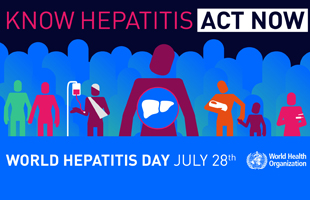
On World Hepatitis Day the World Health Organization (WHO) in Viet Nam calls on policy-makers, health workers and the public to work towards eliminating viral hepatitis as a major public health threat by 2030. Viral hepatitis is a major killer worldwide, claiming an estimated 1.5 million lives each year, a toll that is greater than worldwide deaths from HIV/AIDS, malaria or tuberculosis.
Viet Nam is one of three countries in the Western Pacific that have the highest numbers of people with chronic hepatitis B and C. It is estimated 8.7 million people are living with chronic hepatitis B and one million with hepatitis C. This means the number of people living with chronic viral hepatitis is nearly 40 times the number of people living with HIV in Viet Nam.
Hepatitis B: Effective vaccine and treatment available
While the overall Hepatitis B vaccine coverage in infants in Viet Nam is close to 97%, nearly 1 newborn out of 3 in Viet Nam is missing out on a birth dose of the Hepatitis B vaccine. WHO recommends that all infants should receive their first dose of vaccine as soon as possible after birth, preferably within 24 hours, followed by three doses to complete the vaccine series that provides long-term protection.
Viet Nam’s national EPI provides the Hepatitis B Birth dose vaccine as one of 12 life-saving vaccines free of charge to all Vietnamese children. By delaying vaccination, parents put their children and the broader community at risk of Hepatitis B.
An effective treatment for hepatitis B exists, which is now gradually available in many hospitals in Viet Nam. Treatment can slow the progression of cirrhosis, reduce incidence of liver cancer and improve long term survival.
Hepatitis C: Curable through new effective treatments
There is currently no vaccine against hepatitis C virus, but there has been dramatic progress on treatment for the hepatitis C in the past few years. The introduction of oral medicines, called direct-acting antivirals, has made it possible to potentially cure more than 90% of patients within 2-3 months. Several countries are already finding ways to get services to the people who need them.
These efforts are made easier by the declining price of hepatitis C medicines. Prices are now dropping, particularly in countries that have access to generic drugs.
In Egypt –a lower–middle-income country with one of the world’s highest prevalence rates of hepatitis C – 200 000 people were treated during the past 12 months, and the price of hepatitis C treatment for each person dropped from US$ 900 in 2014 to less than US$ 200 in 2016.
Viet Nam also has potential to access to these new hepatitis C medicines with low costs. To do so, the Ministry of Health is working to update the national treatment guidelines on hepatitis C, and considering the registration and potential financing approach of those new efficacious and safe medicines.
WHO welcomes the on-going efforts of the Ministry of Health and all the stakeholders in Viet Nam to make these new hepatitis C medicines available at affordable costs in the near future.
The vision of eliminating hepatitis as a public health threat by 2030 is attainable. In the Western Pacific Region, WHO assists Member States to fight viral hepatitis through supporting implementation of the WHO Regional Action Plan for Viral Hepatitis in the Western Pacific 2016–2020. The regional action plan provides a systematic approach to priority areas for action to reduce the impact of viral hepatitis.
“Despite progress made in Viet Nam, hepatitis still remains a concern,” said Dr Lokky Wai, WHO Representative to Viet Nam. “But we have effective antivirals that can stop hepatitis B and even potentially reverse the progress of the disease. The vast majority of hepatitis C cases can now be cured in just three months, but treatment has to be made affordable and accessible for people in Viet Nam.”
About Hepatitis
Viral hepatitis is an infection resulting in liver impairment and is caused by one of the five hepatitis viruses: A, B, C, D and E. The five hepatitis viruses are transmitted through different routes: hepatitis A and E through contaminated food and water; hepatitis B through blood and other bodily fluids; hepatitis C and D mostly through blood.
These viruses can all cause acute hepatitis. Most people fully recover from acute infection. However, hepatitis B and C infection can lead to chronic liver disease, which is the most common cause of liver cancer and cirrhosis, which can be fatal.
